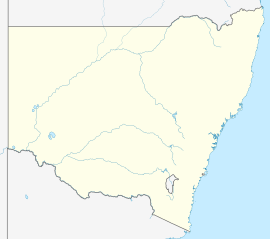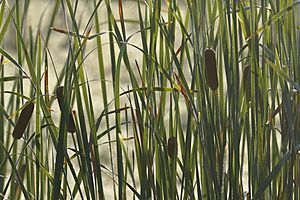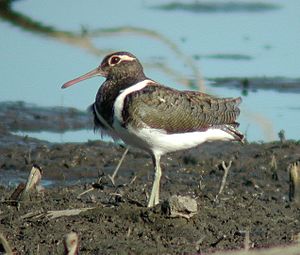Cumbung Swamp facts for kids
Quick facts for kids The (Great) Cumbung SwampNew South Wales |
|
|---|---|
| Nearest town or city | Balranald |
The Cumbung Swamp, also known as the Great Cumbung Swamp, is a huge wetland in New South Wales, Australia. It's where the Murrumbidgee River and Lachlan River meet. When the swamp is full of water, it's a super important home for many birds that travel long distances. It also has one of the biggest reed swamps in the whole Murray Darling Basin.
Contents
What is the Cumbung Swamp?
The Cumbung Swamp is a large area of land covered by reeds and water. It's located in the southwest part of New South Wales, near the town of Balranald. The swamp covers about 15,000 to 20,000 hectares when it's full of water. Even when there's less water, it still covers about 14,000 hectares.
This amazing wetland is made up of thick reed beds and huge areas of River Red Gum forests. These forests are some of the biggest in the entire Murray Darling Basin. In 2019, a group called The Nature Conservancy (TNC) and Tiverton Agriculture bought 33,000 hectares of land around the swamp. They did this to help protect the area and make sure it stays healthy for the future.
Why is the Cumbung Swamp important?
The Great Cumbung Swamp is known across Australia as a very important natural place. It's listed on the Directory of Important Wetlands in Australia. This means its special features are recognized and protected.
The swamp is important for a few reasons. It's one of the largest remaining reed swamps in eastern Australia. It also has unique River Red Gum forests, which are a type of ecosystem that needs protection.
Who lives in the Cumbung Swamp?
The Cumbung Swamp is full of different kinds of plants and animals. It's a very diverse ecosystem.
Plants of the Swamp
The main plants you'll find in the Great Cumbung Swamp are tall reeds. These include Phragmites australis and Typha orientalis, which is also called common cumbungi. There are also many Eucalypt trees, especially River Red Gums (Eucalyptus camaldulensis).
About 2,400 hectares of the swamp are covered by these reed beds. Over 80% of the area is home to River Red Gums. You can also find Lignum (Muehlenbeckia florulenta) and Black Box (Eucalyptus largiflorens) trees, especially on the flood plains. Scientists have found about 207 different plant species here. Over 120 of these plants live in the water.
The old reed beds are a big reason why the Great Cumbung Swamp is so important for conservation. To keep these reeds healthy, they need regular flooding. The flat land around the Lachlan River helps hold water for longer periods, which is good for the reeds.
River Red Gums grow well in areas that flood sometimes. They can survive for up to four years in very dry or very wet conditions. However, changes to how the Lachlan River flows have reduced the floods they need. This has caused some River Red Gums to look unhealthy or even die. Because of this, there's a plan to help protect these forests.
Unfortunately, native plants in the swamp are also threatened by plants that don't belong there. Land clearing, especially around the edges of the wetland, also causes problems. In 2010, a study found that the Cumbung Swamp had too many introduced plant species. It also had a lot of habitat damage.
Animals of the Swamp
The Cumbung Swamp is a rich home for many animals. This includes frogs, fish, mammals, and lots of birds. This is because the Lachlan River and Murrumbidgee River provide a steady water supply.
Frogs are often used as bioindicators to check how healthy a wetland is. A study found four types of native frogs living in the Cumbung Swamp. These included the Barking Marsh Frog and the Great Banjo Frog. The study showed that enough water during summer is important for frogs to breed successfully.
One of the most important things about the Cumbung Swamp is that it's a breeding ground for many waterbirds. It's called "one of the most important waterbird breeding areas in eastern Australia." This is because the large reed beds offer perfect places for birds to build nests. About 131 bird species live here, and many are waterbirds that rely on the swamp's water, especially during dry times.
Some waterbirds you might see include the Straw Necked Ibis and Spoonbills. You might also spot the Australasian Bittern and Australian Painted-snipe, which are both endangered species. Keeping the waterbird population healthy in the Cumbung Swamp is a top priority.
The swamp is also home to many fish species, especially in its deeper parts. Native fish include Murray Cod, Flat Headed Gudgeon, and Australian Smelt. Unfortunately, some fish, like the Silver Perch, are now threatened. This is mainly because changes to river flows affect their homes. To help fish populations, enough water needs to flow into the swamp.
During droughts, the Great Cumbung Swamp also becomes a safe place for land animals. Common mammals found here include the Eastern Grey Kangaroo and Echidna. However, some marsupials like the Sugar Glider are becoming less common due to habitat loss.
Introduced animals, like wild pigs, also cause damage to the habitat. Programs are in place to control their numbers in the area.
Who lived here before Europeans?
Aboriginal groups lived in the Cumbung Swamp area for over 40,000 years before Europeans arrived. These groups included the Nari-Nari, Yida-Yida, Mudi-Mudi, and Gurendji peoples. They all used the rich resources found around the two rivers.
The main group in the Cumbung area was the Wiradjuri people. Their name means "people of three rivers." These rivers were the Macquarie, Lachlan, and Murrumbidgee. The Lachlan and Murrumbidgee rivers formed the southern boundary of their land, right where the Cumbung Swamp is.
The many rivers in this area provided lots of resources for the first peoples. They hunted fish, gathered fruits, and used natural materials for shelter and tools. You can still see evidence of their lives, like scar trees, along the Lachlan and Murrumbidgee Rivers. These trees have marks where bark was removed for canoes or shields.
The Nari Nari Tribal Council is now working with The Nature Conservancy and Tiverton Agriculture (who bought the land) to help manage the area. This partnership ensures that the Nari Nari people's culture and connection to the land are respected and included in protecting the swamp.
Protecting the Cumbung Swamp
The Cumbung Swamp is known as a very important wetland. It's listed on the Directory of Important Wetlands. This means it needs to be carefully managed. In the past, the land was used for farming, which caused some problems. For example, levees (walls to control water) were built in the mid-1800s.
More recently, the land was used for raising cattle. This intense use led to less water stored underground and damage to the River Red Gum forests. Soil also became compacted.
However, in 2019, two large properties, Juanbung and Boyong, were bought for $55 million. These properties include almost 20,000 hectares of the Great Cumbung Swamp. The buyers were an Australian company called Tiverton Agriculture and The Nature Conservancy. Their main goal was to stop harmful irrigation projects and help the natural water flows return.
Since the purchase, TNC and Tiverton Agriculture plan to continue some farming while also protecting the environment. This shows that conservation and making a profit can work together. They also plan to use the land for things like "carbon credits," protecting biodiversity, and ecotourism. All these activities help increase the value of the wetland. Now, over 200,000 hectares in the area are protected. This includes land owned by the government, private groups like TNC, and nearby National Parks.
These plans must also work with bigger water plans for the entire river system. Environmental Water Flows are special amounts of water released to help the swamp. By watching how the Lachlan River flows, experts can see how river changes affect the swamp's health. For example, a study in 2010 found that a certain amount of water was needed to flood the reed beds.
In 2015-2016, 24,000 megalitres of water were given to the swamp specifically for the environment. This "environmental watering" helps the ecosystem stay healthy. It helps with things like nutrient cycling and helps plants and animals survive droughts and floods.
By carefully watching and managing the Cumbung Swamp and the Lachlan and Murrumbidgee rivers, we can help this important Australian wetland survive and thrive.




